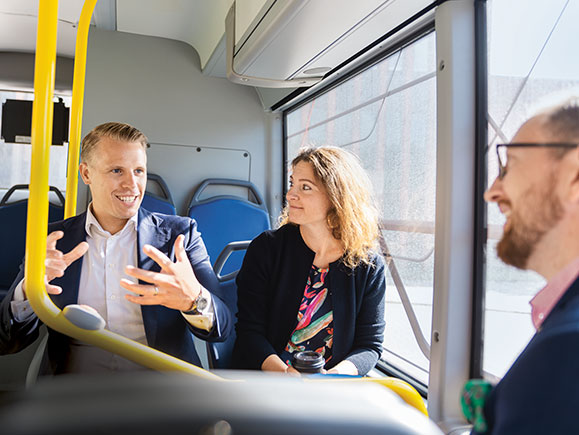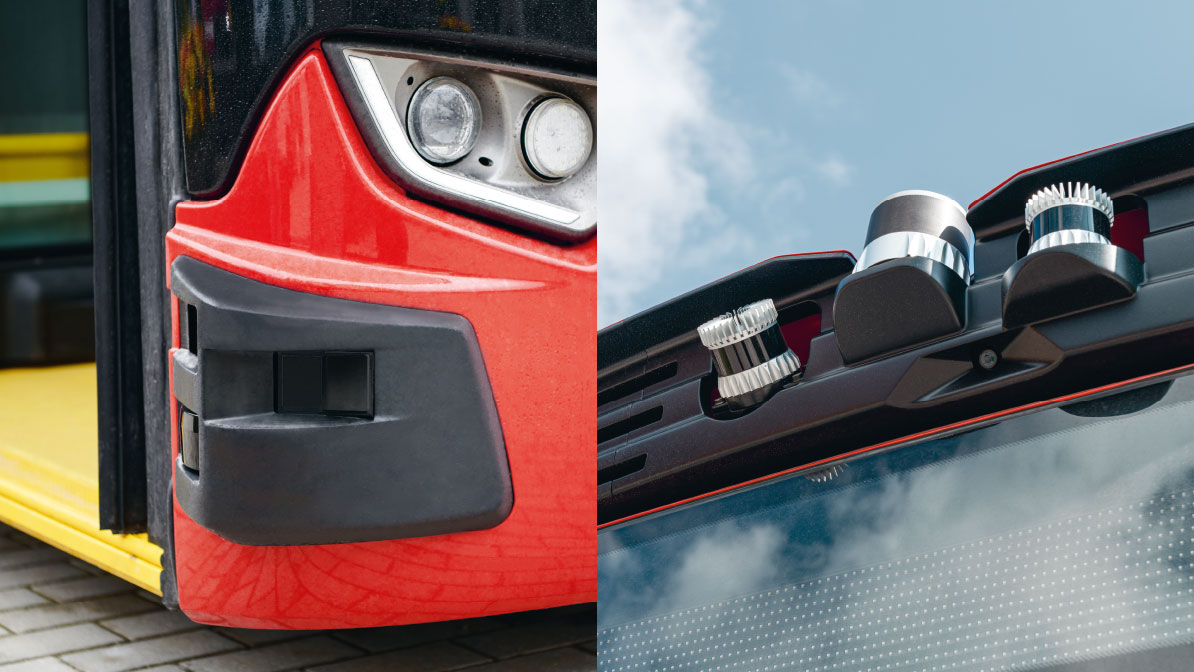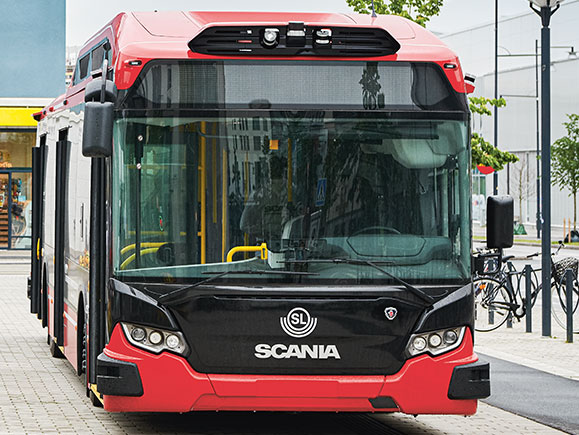Scania is developing autonomous buses for the mobility of the future. In the residential area of Barkarby, around 20 kilometers north of Stockholm, an entirely new transportation infrastructure is being built. That is the perfect combination for a trial run.
Whether bus drivers want to hear it or not, autonomous buses will be safer on the road than a driver behind the wheel could ever be. “The computer will never drive too fast and is never tired or distracted; it recognizes danger much earlier and reacts a lot more quickly,” says Camilla Lood, developer of business models for autonomous vehicles at Scania in Södertälje. She’s sitting in the prototype of a battery-powered electric Scania Citywide LF.
No, the bus is not yet driverless. But the project partners aren’t worried about that, because the city where it will later be deployed technically doesn’t exist yet either. Barkarby, a small residential area about 20 kilometers north of Stockholm, is currently being prepared for the future. Similar to China, where cities with a population of over a million are planned and built from the ground up, a city center is currently being built here in Barkarby—albeit on a much smaller scale. “Barkarby is the perfect city for developing and trialing autonomous driving capabilities,” explains Lood. “Everything is only just being planned and built. From the outset, the new infrastructure is being designed to be as car-free as possible to promote the use of public transportation.” For a project like this to be successful, many pieces of the puzzle have to fit together: the Barkarby municipality is building the required infrastructure, Scania is developing the buses, and Nobina, a public transportation operator, will run them.

Scania project manager Martin Ottensjö sees rapid developments in sensor technology.
“We don’t have to build completely new buses; we can use the existing platform as the basis and retrofit the autonomous system technology.”Martin Ottensjö
Technical project manager, Scania
200engineers are working on autonomous driving at Scania.
“In Barkarby, separate bus lanes are being built, among other things. Where that’s not possible, we are installing sensors in traffic lights that communicate with the bus and give it right of way,” says Daniel Mohlin, manager at Nobina responsible for the implementation of new services. “The infrastructure is the most visible and also the most expensive part of the project. When the bus lanes and traffic lights are finished, we will work out a schedule—and then autonomous buses can be put into operation,” says Mohlin.
The partners are sure that by that time, they will have received the necessary legal approvals. “Sweden has a long automotive history. To continue the industry’s global success, lawmakers will have to look ahead and be open to new things,” Mohlin explains confidently. Besides, there were also no major issues during the approval process two years ago, when a trial run was launched with smaller autonomous shuttles.
Existing platform as the basis
Why doesn’t Scania go down the same road of testing with smaller shuttle buses first instead of going straight for a 12-meter-long city service bus? “Because that’s the product that public transportation operators and customers already know and like,” responds Lood, “although in the future, we will see a lot more multimodal systems and combinations, including micro mobility, to get really attractive public transportation.” Her coworker Martin Ottensjö adds, “We don’t have to build completely new buses; we can use the existing platform as the basis and retrofit the autonomous system technology.” However, that is no easy task: 200 engineers are working on autonomous driving at Scania. The greatest challenge is setting priorities and working through them in the right order. And the rapid development of the sensor technology isn’t necessarily making the work easier: by the time production starts, the technology will most likely have developed by leaps and bounds. That’s why the exact sensor configuration using cameras and radar and lidar sensors is determined as far down the line as possible.

A conversation between Nobina manager Daniel Mohlin (left) and his partners at Scania, Camilla Lood and Martin Ottensjö.
“The infrastructure is the most visible and also the most expensive part of the project.”Daniel Mohlin
Manager at Nobina
The bus is already covered in sensors. On the front face of the bus alone, there are eight cameras and three lidar sensors; then there are two more lidar sensors and two cameras on the top front sides, as well as another radar and lidar sensor on each of the two bottom corners. The rear of the bus is similarly equipped. What is remarkable is how inconspicuously Scania has been able to integrate the technology. The everyday passenger would hardly notice it. And that is also part and parcel of the strategy: in the future, passengers should see autonomous buses as just an everyday part of getting around the city.
Even though the sensors are already installed, the control cabinet where the many cables come together is still empty. The decision as to which central server will be used is still to be made. Its hardware must be immensely powerful to be able to process the vast amounts of data from the sensors in near real time. In the future, this will also be supported by artificial intelligence. “The vehicles have to develop a better perception of their environment to be able to make more intelligent choices in their driving, both for safety reasons and in order to be more proactive,” says Lood.

A bus needs many sensors to drive autonomously—even at the very top and bottom of the vehicle.

Prototype of the battery-powered electric Scania Citywide LF
The driver is not being replaced
This leads us to an insight that Nobina has already gained through operating the small shuttles: the buses and infrastructure work; what complicates things is people parking illegally, cyclists riding in the wrong direction, or drivers who cut in too close in front of the bus. To be able to handle these situations safely, a safety driver will have to sit behind the wheel for a long time to come.
But at some point the question will come up: what will happen to the driver who ultimately makes up a good portion of the operating costs? According to Daniel Mohlin, for bus operations in Sweden, almost 60% of total operating costs are attributed to the driver. An autonomous bus is not bound by rest periods, and could be on the road 24/7, greatly increasing efficiency and saving costs.
“Even so, our aim is not to take the driver out of the bus. But he or she could take over other tasks,” says Mohlin. After all, passengers will still require help: they want to know what ticket they need and where they have to get off, or they might need help with a wheelchair. Besides, they feel safer when they aren’t sitting alone in the bus at night. Personal contact with passengers will still have a place in the future. Camilla Lood, Martin Ottensjö, and Daniel Mohlin are working together to figure out what that will look like.

Bus chats: Daniel Mohlin and Camilla Lood
“The vehicles have to be able to make more intelligent choices.”Camilla Lood
Business development manager, Scania


.jpg/jcr:content/Teaser-Grafik-Tiva-Sharifi-3840x2560-V1-(1).jpg
)
.jpg/jcr:content/Teaser-Grafik-Mansoureh-3840x2560-V1-(1).jpg
)



